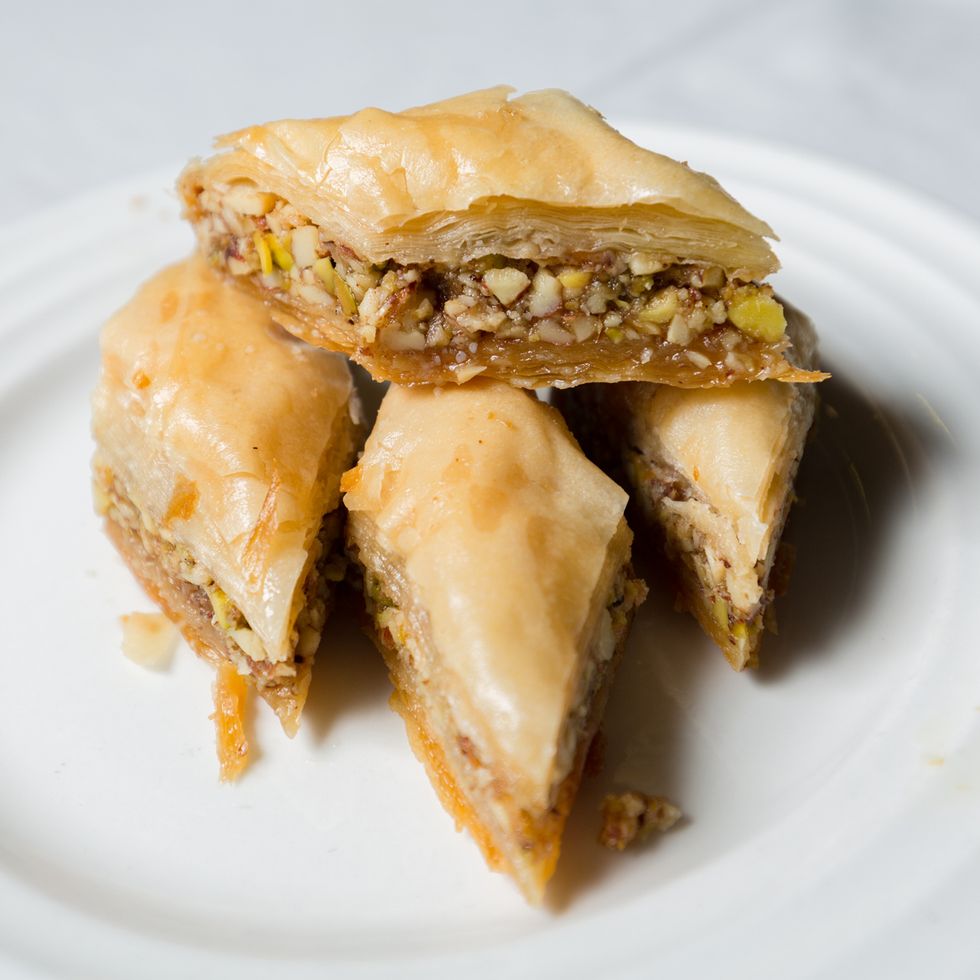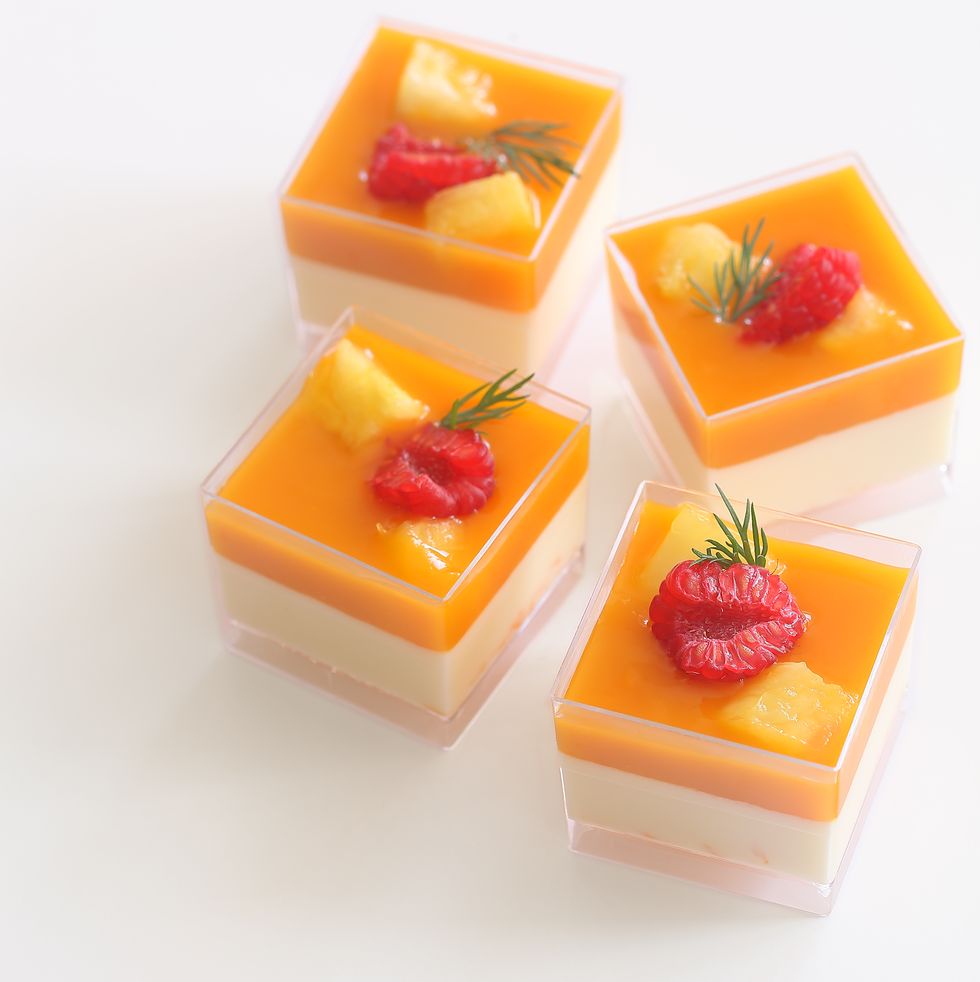Eid al-Fitr is one of two major holidays on the Muslim calendar. Though both holidays are often called Eid, there’s a difference between Eid al-Fitr and Eid al-Adha. Eid al-Fitr comes first and takes place in the 10th month of the Muslim calendar. Eid al-Adha, on the other hand, is celebrated in the 12th month of the Muslim calendar and occurs 70 days after the first holiday. (If you need help remembering, think of Fitr = First, Adha = After.)
Apart from their timings on the calendar, there are other major differences between the two holidays. Eid al-Fitr takes place after fasting Ramadan and has culturally gained the moniker “The Sugar Feast” or “The Festival of Sweets” because of the sweet treats enjoyed on this holiday. In contrast, Eid al-Adha takes place after the Hajj pilgrimage and is known as “The Sacrifice Feast” with holiday menus having a stronger focus on meat and savory foods. A tradition for consuming sweets on Eid al-Fitr likely started from early Muslims in Medina, Saudi Arabia, using available cooking ingredients such as dates and honey for their festivities. The sugar content of both foods is a great energy boost after a month of fasting. As Islam spread to more geographic regions, each culture used its available ingredients and culinary know-how for their Eid al-Fitr celebrations resulting in the myriad of dishes we have today.
In celebration of Eid al-Fitr, let’s take a look at some of the sweet delicacies different Muslim cultures make for this special time of year.
 Sanjay Borra
Sanjay Borra
1
Baklava
The Oxford Companion of Food states that although North Americans typically know phyllo pastry by its Greek name, the dough is traced back to Turkic origins. In Ottoman Istanbul, the city would host a Baklava Parade on the 15th of Ramadan. Today, the dish still remains a big part of Ramadan and Eid al-Fitr. Many families opt for store-bought baklava nowadays; but some families, particularly those with Turkic and Balkan origins, make a big tray of baklava from scratch for Eid al-Fitr, passing down family recipes generation to generation.
 Alex Bayev / 500px//Getty Images
Alex Bayev / 500px//Getty Images
2
Mango Custard
Mango custard has become a cherished Eid al-Fitr delight, especially in Muslim countries where the love for mangos is deeply rooted. Mango pulp seamlessly replaces fresh fruit during off-seasons, and when combined with cake, it becomes a mango trifle.
 raiyanimuharramah3
raiyanimuharramah3
3
Sweet Samosas
In Morocco, these are known as briouat, whereas in the Arabian Gulf, the name sambusa hilwa is more common. In each version, phyllo dough is shaped into triangular pockets and then stuffed with a sweet filling. Fruits such as pears and apples or syrup-soaked nuts are popular stuffings. Alternatively, phyllo might be rolled into a cigar shape (instead of a triangle) and stuffed with a sweet cream, similar to a cannoli.
Advertisement – Continue Reading Below
 Stefan Tomic//Getty Images
Stefan Tomic//Getty Images
4
Crème Caramel
Crème caramel enjoys popularity as an Eid al-Fitr dessert, particularly in Middle Eastern and South Asian regions. Its silky caramel layer atop velvety custard is a cherished treat for the holiday and easy enough to make at home (and also readily available to buy).
 3dotsad
3dotsad
5
Kanafeh
A favorite at Middle Eastern restaurants, this dessert is a top pick for Eid al-Fitr in Levant cultures. For this dessert, shredded phyllo dough is paired with a white cheese, such as Nabulsi or Akkawi cheese. It’s served with a drizzle of fragrant sugar syrup, usually as a rectangular slab of cake.
 ShashikantDurshettiwar
ShashikantDurshettiwar
6
Vermicelli
Saviya is a popular dessert with South Asian Muslims on Eid al-Fitr. It is made by stir frying vermicelli, ghee, sugar, and aromatic spices such as cardamom. Many families enjoy saviya right after Eid prayer for brunch or breakfast. A similar counterpart, sheer khurma, is equally popular. It also uses vermicelli as a primary ingredient, but the vermicelli is cooked in a milk base (often overnight). The dessert is akin to a sweet noodle soup; based on personal preference, some serve it cold and others serve it hot.
Advertisement – Continue Reading Below
 vaaseenaa
vaaseenaa
7
Stuffed Dates
Dates are delicious on their own, but for Eid al-Fitr, many people prefer to dress them up with stuffings. Common stuffings include whole nuts, nut butters, cream cheese and sweet pastes made from nuts, honey, and rose water.
 Sherif A. Wagih
Sherif A. Wagih
8
Filled Cookies
In Egypt, kahk — a crumbly butter cookie stuffed with a date paste ball and sprinkled with icing sugar — is a family favorite for Eid al-Fitr. In other countries, such as Palestine, a date stuffed cookie called maamoul takes precedence on the Eid table. Yet still in Indonesia, cookies stuffed with pineapple jam are the popular choice for Eid.
 Larry Washburn
Larry Washburn
9
Butter Cookies
Vanilla, chocolate, lemon, cardamom, and almond are just a sampling of butter cookie flavors enjoyed on Eid al-Fitr. Names and offerings differ from region to region. For example, you might find ghraybeh in the Middle East, naan khatai in South Asia, or crescent-shaped sable cookies in North Africa.
Advertisement – Continue Reading Below
 Pastry and Food Photography//Getty Images
Pastry and Food Photography//Getty Images
10
Agar Agar Pudding
Agar agar pudding holds a cherished place in Sri Lankan Eid celebrations, where its cool, jiggly texture and sweet flavor make it a delightful and traditional festive treat. Families often share this unique dessert as part of their joyous Eid festivities.
RELATED: Eid al-Fitr Gifts for Everyone in the Family
 joxxxxjo
joxxxxjo
11
Kuih Lapis
In Southeast Asia, kuih lapis, or kue lapis, is a steamed cake so labor-intensive it’s saved just for special occasions like Eid al-Fitr (natively called Hari Raya or Lebaron). Made of rice flour, sago, coconut milk, eggs and sugar, it’s a colorful cake with a jelly-like texture, similar to custard. Lapis is just one type of kuih (traditional snack) enjoyed for Eid; many more kuih varieties exist.
 FotografiaBasica
FotografiaBasica
12
Nishallo
In Uzbekistan and neighboring Central Asian cultures, the month of Ramadan brings with it the good news of nisholda or nishallo. Egg whites are whipped and combined with sugar and plant roots, usually licorice root. Almost like a marshmallow fluff, it’s served with naan for a sweet finish to a meal.
Advertisement – Continue Reading Below
 Francesco Marzovillo
Francesco Marzovillo
13
Nougat
Similar to licorice, the Oxford Companion of Food traces nougat’s roots back to Central Asia and Iran. Later spreading to Arabia and Andalusian Spain, nougat has been a favorite treat for Eid al-Fitr from at least the 10th century.
 bernashafo
bernashafo
14
Turkish Delight
Although its name might suggest origins in Turkey, Turkish delight is said to have originated in Iran. Called lokum in Persian, these tiny bites come in a variety of flavors and textures, from jelly-like to marshmallow soft.
 vm2002
vm2002
15
Semolina Desserts
There are endless ways semolina makes its way into Eid al-Fitr desserts. In some cultures, semolina is stir fried with eggs, ghee, and sugar to make a sweet dish called halwa. In others, cooked semolina is combined with date pastes and set into molds to make a type of fudge. Semolina is also used as a base for traditional puddings — or when mixed with olive oil and honey, it’s semolina cake for Eid!
Advertisement – Continue Reading Below
 PicturePartners
PicturePartners
16
Fatira and Cambaabur Bread
In Africa, thin, crepe-like pancakes take centre stage for Eid al-Fitr. In Ethiopia, fatira is a pancake enjoyed with honey for breakfast on Eid. In neighbouring Somalia, cambaabur is a pancake sprinkled with sugar and yogurt.
 mirrorr
mirrorr
17
Sweet Buns
In Yemen, khaliat nahal are beautiful buns glazed with honey and baked in a honeycomb pattern for Ramadan and Eid. In Iraq, kleicha are buns rolled with a date jam for a sweet Eid breakfast.
 Adina Vlasceanu / 500px
Adina Vlasceanu / 500px
18
Donuts
Fried foods are popular throughout Ramadan, and on Eid al-Fitr, fried sweets are a crowd pleaser! Churro-like donuts with various names are found throughout Muslim cultures. In Libya, they go by the name sfinz and are topped with date molasses and sprinkled sugar.
Advertisement – Continue Reading Below
 Owen Franken//Getty Images
Owen Franken//Getty Images
19
Petit Fours
Petit fours have gained popularity as elegant Eid al-Fitr desserts. These bite-sized, intricately decorated pastries are enjoyed by communities in areas like North Africa, Lebanon, and France.
 santhosh_varghese
santhosh_varghese
20
Sweet Porridge
In Senegal, lakh is a type of sweet porridge made from curdled milk and millet. It’s traditionally consumed right after returning home from Eid prayer. Adding baobab fruit is a common way the porridge is dressed up for the occasion. Other West African cultures similarly enjoy a sweet porridge, also known as thiakry or degue, on Eid.

